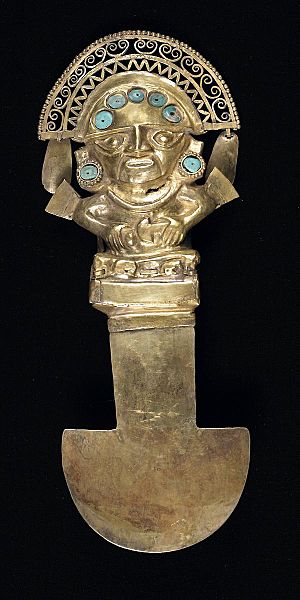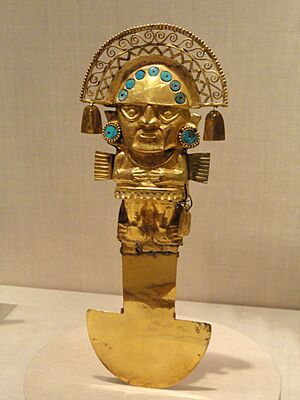Tumi facts for kids

A Tumi (pronounced TOO-mee) is a special kind of knife or sharp tool from the ancient Andes Mountains region in South America. The word "Tumi" comes from the Quechua language, meaning 'knife'.
These tools were used for many different things. People used tumis as kitchen knives, farm tools, or even as extra weapons for warriors and hunters. They were also used for cutting hair, as jewelry, or as medical tools. Sometimes, tumis made of metal were even used as a type of money! Ancient tumis were usually made from metal or stone.
Contents
What is a Tumi?
The most famous tumis are often beautiful, ax-shaped knives. These were made by ancient cultures along the northern coast of Peru. They usually have a half-circle blade. These special tumis were crafted from bronze, copper, gold, silver, or wood. Often, they were decorated with pretty stones like lapis lazuli.
Tumis in Ancient Ceremonies
Many ornamental tumis are linked to cultures that lived in Peru before the Inca. These include the Chimu and the Sican cultures. These knives were very important in their ceremonies.
The Inca people believed they were descendants of the Sun God, Inti. Every year, they held a big celebration called Inti Raymi (which means "sun festival" in Quechua). This festival thanked the Sun for good harvests of potato and maize. During this important event, a high priest would use a tumi. He would perform a ritual with a llama to help predict the future. After the ceremony, the animal was completely burned.
Tumis in Ancient Surgery
Archaeologists have found that ancient Andean cultures, like the Paracas and Inca, used tumis for a type of brain surgery. This surgery is called skull trepanation. It involved carefully making a hole in the skull. Many of these operations were done very skillfully. This suggests they were not just for injuries, but perhaps for other health problems too.
The tumi knives used for surgery were different from the fancy ceremonial ones. Surgical tumis were made of stronger materials. The beautiful tumis from the Lambayeque and Chimu cultures were often made of softer metals. This meant they were mostly for symbolic use in ceremonies, not for actual cutting.
Finding Ancient Tumis
In the northern coastal area of Peru, special tumi knives were made for rituals. Important people in society used them, even in burial ceremonies. In 2006, archaeologists found 22 ancient graves in northern Peru. Inside, they discovered the first semi-circular metal tumi knives ever found by scientists. Before this, all known tumis had been found by people who illegally dug up graves.
The Illimo Tumi and Naylamp
In 1936, a Sican tumi was found in Peru. It was more like an ax than a knife, weighing almost a kilogram and standing 41 centimeters tall. Many Sican tumis show the figure of Naylamp. Naylamp was a legendary hero and the founder of the Sican culture. The myth says he was born from a special bird with the same name. When Naylamp died or disappeared, he grew wings and flew into the sky.
Naylamp built a temple called Chot. There, he placed a large stone he named Llampallec, meaning "statue of Ñaylamp." Many ceremonies were held in this temple using a tumi. The famous Illimo Tumi shows a bird mask, wings, and bird-shaped eyes. This represents the birdman Naylamp. Sican tumi knives often show birds or wings to symbolize Naylamp. However, images of Naylamp, the "Sican Lord," stopped appearing in Sican art later on. This was when the Sican culture focused more on nature, like felines, fish, and birds.
Tumis Today
In modern Peru, hanging a tumi on a wall is believed to bring good luck. The tumi is now a national symbol of Peru. You can often see it in Peruvian tourism ads and on souvenirs like mugs and keychains.
See also
 In Spanish: Tumi para niños
In Spanish: Tumi para niños
|



